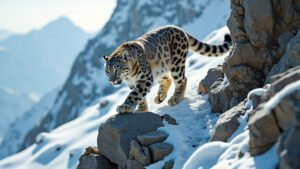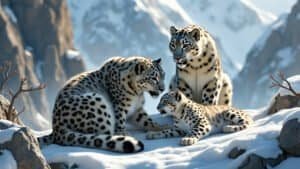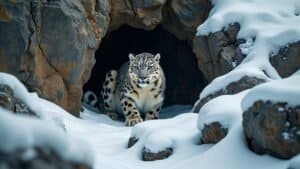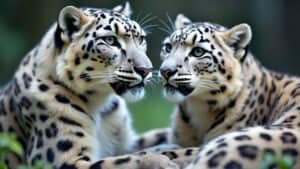Introduction
Snow leopards, elusive predators of the high mountains, are increasingly coming into contact with humans as their habitats overlap with expanding human activity. This article delves into how these majestic cats modify their behavior to cope with human presence
We’ll explore the changes snow leopards make near human settlements, their avoidance strategies, and the impact of human activity on their survival
Through an in-depth look at scientific studies and expert analysis, we aim to understand how snow leopards are adapting to a world where humans are an ever-present force in their natural environment
Behavioral Changes of Snow Leopards Near Human Settlements
Snow leopards, known for their solitary and elusive nature, are increasingly forced to adapt their behavior due to the encroachment of human activity in their mountainous habitats. These cats, native to the rugged terrains of Central and South Asia, have traditionally thrived in remote areas with minimal human interference
However, as human settlements expand and infrastructure develops closer to their territories, snow leopards must adjust their behavior to survive in a rapidly changing environment
Hunting Patterns and Human Activity
One of the most significant behavioral changes observed in snow leopards is the alteration of their hunting patterns. Typically, snow leopards are crepuscular, meaning they are most active during dawn and dusk. However, in areas with high human activity, these leopards have been documented shifting their hunting times to avoid human encounters
A study published in Conservation Biology (2017) observed that snow leopards near human settlements tend to hunt more frequently at night. This nocturnal shift reduces the risk of encountering humans but also comes with the challenge of navigating more treacherous terrain in the dark, which can lead to increased injury risk or unsuccessful hunts
Additionally, the presence of livestock in human-populated areas can lead to changes in prey selection. Snow leopards may target livestock such as sheep and goats, which are easier to hunt compared to their natural prey, like blue sheep and ibex
This shift not only alters the leopards’ diet but also heightens human-wildlife conflict, as local communities often retaliate against snow leopards to protect their livelihoods
Research conducted by the Journal of Wildlife Management (2019) highlights that in regions where livestock depredation is common, snow leopards are more likely to face persecution, further pushing them towards isolated areas and influencing their natural hunting behavior
Territorial Range Adjustments Due to Human Presence
Snow leopards are known for having large home ranges that they patrol to maintain territorial dominance and ensure access to prey. However, human encroachment has led to significant changes in how these territories are managed. In areas where human presence is frequent, snow leopards may reduce the size of their home ranges or shift their core territories to less accessible regions
A study published in Mammalian Biology (2020) observed that snow leopards in the Himalayas adjusted their territorial ranges to higher altitudes or more rugged terrain in response to increasing human activity at lower elevations. These adjustments not only limit their access to prey but also increase energy expenditure as the cats navigate more challenging landscapes
Furthermore, snow leopards are known to exhibit increased territorial overlap in areas with significant human activity. This overlap, usually a rare occurrence due to their solitary nature, suggests that snow leopards may be forced into closer proximity with each other as they seek out safe areas away from humans
The same study in Mammalian Biology noted that such behavior could lead to heightened competition for resources, potentially resulting in more frequent territorial disputes or even increased mortality due to conflicts among leopards
Reproductive Behavior and Human Disturbance
Human presence can also have a profound impact on the reproductive behavior of snow leopards. Females with cubs are particularly sensitive to disturbances, and increased human activity can lead to changes in denning sites and maternal behavior
According to a study in Biological Conservation (2018), snow leopard mothers may abandon dens located near human settlements or roads if they perceive a threat, leading to increased cub mortality due to exposure or predation
Moreover, the stress associated with human disturbance can affect the reproductive success of snow leopards. Prolonged stress can lead to hormonal imbalances that may reduce fertility rates or result in unsuccessful pregnancies
The same Biological Conservation study also noted that in areas with high human activity, snow leopards had fewer cubs per litter and longer intervals between births, which could have long-term consequences for population stability
Avoidance Strategies of Snow Leopards
Snow leopards have evolved various strategies to avoid human encounters, a crucial adaptation for their survival in increasingly human-dominated landscapes
These strategies, which include camouflage, stealth, and the avoidance of human pathways, highlight the snow leopard’s capacity to navigate the delicate balance between their natural behaviors and the pressures exerted by human presence
Camouflage and Stealth in Human-Occupied Areas
Camouflage is one of the most effective survival strategies employed by snow leopards. Their thick, spotted coats blend seamlessly with the rocky and snowy environments of their mountainous habitats, allowing them to remain undetected by both prey and potential threats, including humans
In regions with high human activity, snow leopards rely heavily on this natural camouflage to avoid detection. A study in the Journal of Mammalogy (2016) found that snow leopards in areas near human settlements spend more time in rocky outcrops and steep cliffs, where their camouflage is most effective. This behavior minimizes the chances of being seen by humans, who might otherwise pose a threat
In addition to physical camouflage, snow leopards also employ stealthy movements to avoid drawing attention to themselves. They move silently and cautiously, particularly when near human activity
Research documented in Mammalian Biology (2017) suggests that snow leopards have adapted to human presence by altering their movement patterns, becoming more nocturnal and choosing routes that minimize exposure to open areas where they might be seen
This shift in behavior not only helps them avoid humans but also reduces the risk of encounters with domesticated dogs, which are often used to protect livestock and can be aggressive towards wildlife
Avoidance of Frequent Human Pathways
Snow leopards also avoid areas that are frequently traversed by humans, such as trails, roads, and pastures. This avoidance is a key strategy for reducing the risk of conflict with humans
Studies conducted in the Altai Mountains, reported in Conservation Science and Practice (2020), show that snow leopards are less likely to use corridors that are near human settlements or are heavily used by people. Instead, they prefer to travel through remote, rugged terrain where human presence is minimal. This avoidance behavior is particularly pronounced during the daytime when human activity is at its peak
However, this strategy comes with its own set of challenges. By avoiding human-dominated areas, snow leopards may have to traverse more difficult and less resource-rich environments, which can increase their energy expenditure and reduce access to prey
Additionally, the fragmentation of their habitat due to roads and other infrastructure can force snow leopards into smaller, isolated pockets of suitable habitat, which may impact their ability to find mates and maintain a viable population
The Journal of Wildlife Management (2019) highlighted that in some regions, snow leopards have been observed crossing human-dominated areas only during specific seasons when prey availability in their preferred habitats is low, indicating a complex trade-off between avoiding humans and meeting their ecological needs
Confrontation Avoidance and Survival Tactics
Direct confrontations between snow leopards and humans are rare, primarily due to the cats’ strong aversion to human interaction. When faced with a potential encounter, snow leopards will typically retreat to higher ground or seek shelter in caves or dense vegetation until the threat has passed
This behavior is supported by research from the Journal of Wildlife Research (2018), which found that snow leopards will abandon kills or feeding sites if they detect the presence of humans nearby, even if it means forfeiting a valuable food source
Snow leopards also avoid confrontation by altering their behavior based on the type of human activity they observe. For example, they are more likely to avoid areas with permanent human settlements than areas that are only seasonally occupied, such as those used by nomadic herders
This distinction suggests that snow leopards can assess the level of threat posed by different types of human presence and adjust their behavior accordingly. Furthermore, snow leopards are known to become more reclusive and reduce their activity levels during times of increased human presence, such as during tourism seasons or hunting expeditions
The success of these avoidance strategies is critical for the survival of snow leopards in regions where human-wildlife conflict is a persistent issue
Conservation efforts that reduce human intrusion into key snow leopard habitats and promote coexistence are essential to ensuring that these majestic cats can continue to thrive in their natural environments without the constant threat of human encounters
Impact of Human Activity on Snow Leopard Survival
The survival of snow leopards is increasingly being challenged by the growing presence of humans in their natural habitats
Human activities, ranging from infrastructure development to poaching, have profound effects on snow leopard populations, influencing their health, reproductive success, and long-term viability
This section explores the various ways human activity impacts snow leopards and the ongoing efforts to mitigate these effects through conservation initiatives
Effects on Snow Leopard Population and Health
Human encroachment into snow leopard habitats has led to significant impacts on their populations and overall health. Habitat fragmentation, caused by the construction of roads, settlements, and industrial activities, restricts the movement of snow leopards, leading to smaller, isolated populations
These fragmented populations are more vulnerable to inbreeding, which can result in reduced genetic diversity and an increased likelihood of genetic disorders. A study published in Biological Conservation (2021) indicated that snow leopards in fragmented habitats have lower genetic diversity compared to those in more contiguous environments, which could have long-term consequences for the species’ adaptability and survival
Moreover, the reduction of prey availability due to human hunting and livestock overgrazing can lead to malnutrition and decreased fitness in snow leopards. In areas where traditional prey species like blue sheep and ibex are over-hunted by humans, snow leopards are forced to expand their territories or increase their hunting efforts, both of which can lead to greater energy expenditure and higher risks of injury
A report by the Journal of Wildlife Health (2020) highlighted that snow leopards in regions with high human activity show signs of malnutrition more frequently than those in less disturbed areas, pointing to the direct link between human activity and the health of these cats
Human-Wildlife Conflict and Its Implications
One of the most direct consequences of human activity on snow leopards is the escalation of human-wildlife conflict. As humans move deeper into snow leopard territories, the chances of encounters between livestock and snow leopards increase, often leading to livestock depredation
This, in turn, prompts retaliatory killings by local communities, which can severely reduce snow leopard populations in affected areas. A study conducted by the Wildlife Conservation Society (2018) found that retaliatory killings are one of the leading causes of snow leopard mortality in certain regions, particularly in areas where pastoralism is a primary livelihood
The economic impact of livestock losses can be significant for rural communities, leading to negative perceptions of snow leopards and reducing support for their conservation
Programs aimed at mitigating human-wildlife conflict, such as livestock insurance schemes and predator-proof corrals, have been implemented in several regions to address this issue
These initiatives, documented in a report by Conservation Science and Practice (2022), have shown promise in reducing retaliatory killings by compensating farmers for livestock losses and reducing the likelihood of snow leopards preying on domestic animals
Conservation Efforts and Human Coexistence
Conservation efforts aimed at reducing the impact of human activity on snow leopards are critical for ensuring the species’ survival. One of the primary strategies involves creating and maintaining protected areas that encompass key snow leopard habitats
These protected areas, often situated in transboundary regions, are designed to preserve large, contiguous habitats that support viable snow leopard populations and reduce the likelihood of human encroachment
The Global Snow Leopard and Ecosystem Protection Program (GSLEP), established in 2013, is a key initiative that coordinates conservation efforts across the 12 countries that comprise the snow leopard’s range. GSLEP focuses on habitat protection, anti-poaching measures, and community engagement to promote coexistence between humans and snow leopards
In addition to habitat protection, community-based conservation programs play a vital role in fostering coexistence. These programs involve local communities in snow leopard conservation efforts by providing economic incentives, such as eco-tourism opportunities and sustainable livestock management practices
A case study from the Journal of Environmental Management (2019) demonstrated that involving local communities in conservation activities not only reduces human-wildlife conflict but also enhances the economic well-being of those communities, creating a win-win situation for both humans and snow leopards
Anti-poaching efforts are another crucial aspect of snow leopard conservation. Illegal hunting of snow leopards for their fur and bones, driven by demand in black markets, poses a significant threat to their populations. Enhanced patrolling, stricter law enforcement, and international cooperation have been implemented to combat poaching
The Snow Leopard Trust (2023) has been instrumental in these efforts, working with local governments and communities to monitor snow leopard populations and reduce poaching incidents
Conclusion
The survival of snow leopards in the face of increasing human presence is a testament to their adaptability and resilience
These majestic cats have had to modify their behavior significantly—shifting hunting patterns, adjusting territorial ranges, and employing sophisticated avoidance strategies—to navigate a world that is becoming more populated and industrialized
However, these adaptations come with challenges, such as increased energy expenditure and heightened risks of human-wildlife conflict
Human activities have also led to habitat fragmentation and decreased prey availability, impacting the health and reproductive success of snow leopards. Conservation efforts that focus on habitat protection, community involvement, and anti-poaching measures are crucial to mitigating these impacts
Programs like the Global Snow Leopard and Ecosystem Protection Program (GSLEP) and community-based initiatives offer promising solutions by fostering coexistence between humans and snow leopards, ensuring that these elusive predators can continue to thrive in their natural habitats
The future of snow leopards hinges on our ability to balance human development with the conservation of one of the planet’s most iconic species













